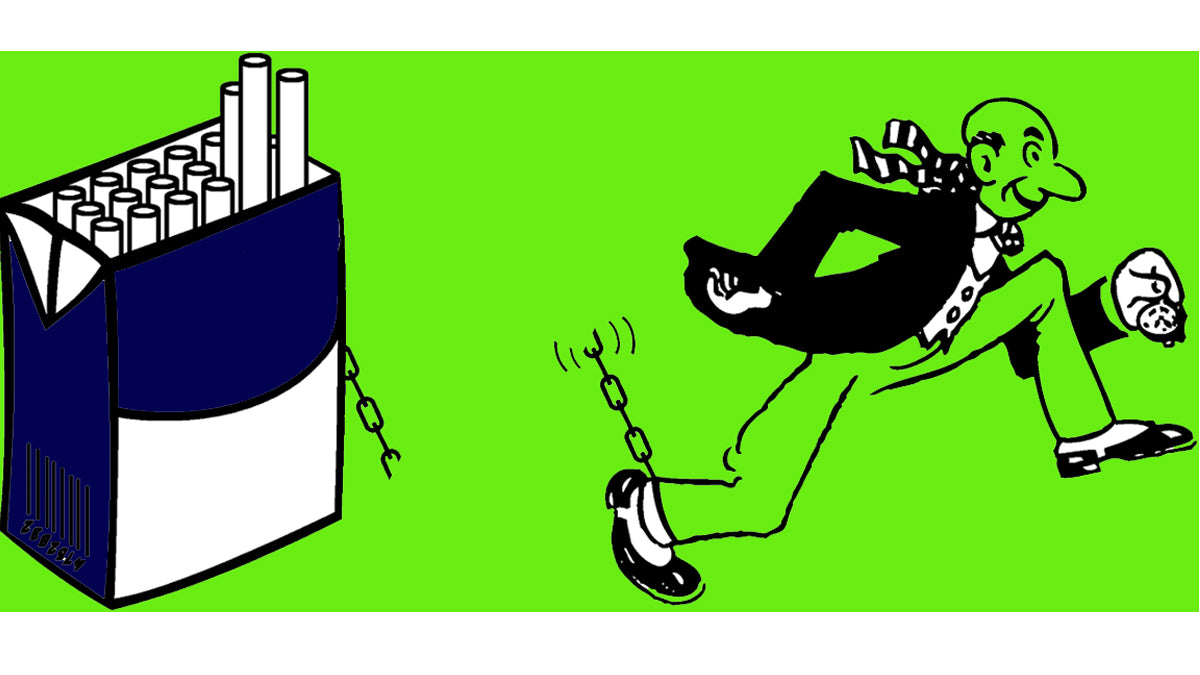Discover the Power of NRT: Unveiling its Surprising Impact on Tobacco Consumers
Introduction
The practice of smoking has afflicted people and civilisations for ages. It is well known for its harmful health effects and capacity to prolong nicotine addiction. NRT stands for nicotine replacement treatment, which is one of the most well-liked and effective methods of quitting.
We'll explore NRT, such as nicotine replacement therapy gum, in this post, understand its significance, and learn how it might transform the smoking cessation process.
Power of NRT: Why is NRT Important?
Understanding the Struggle
Nicotine addicts make serious attempts to stop smoking despite the difficulty of the procedure. Nicotine addiction is quite strong. Consequently, it may be challenging to cease utilising it on your own. But in this case, NRT, or nicotine replacement treatment, is crucial.
The following examples further explain the reasons why NRT is essential.
Addressing the Cravings
Nicotine addiction is a complex issue. The strong urges to smoke that smokers experience constitute a significant factor in this addiction. These cravings can be overwhelmingly intense, making it extremely difficult for individuals to Quit Smoking without support. NRT plays a pivotal role in addressing this issue.
NRT assists in satisfying the body's desire for nicotine by offering a controlled and reliable source of the chemical while protecting users from the adverse effects of smoking. By reducing the intensity of cravings, this controlled method helps people resist the impulse to take up a cigarette.
A Gradual and Controlled Reduction
One of the most compelling aspects of NRT is that it allows individuals to reduce their nicotine intake gradually. This approach starkly contrasts with quitting "cold turkey," which involves an abrupt cessation of nicotine use.
Without help, quitting smoking may be extremely difficult on the body and the psyche. A sudden cessation of nicotine use may result in solid cravings, irritability, mood swings, and other difficult withdrawal symptoms. These discomforts may become so severe as to cause relapses. NRT, such as nicotine replacement therapy gum, on the other hand, provides a structured and gradual reduction of nicotine intake. It enables users to gradually wean off nicotine at a speed more suited to their physical and mental needs.
A Safer Source of Nicotine
The health concerns linked to smoking are caused by the poisons and dangerous compounds found in cigarette smoke. When people smoke, they expose themselves to these harmful chemicals and nicotine.
NRT offers a safer alternative to stop smoking. It substitutes a controlled, pure source of nicotine for the dangerous one present in cigarettes. The harmful ingredients found in tobacco smoke are absent from the nicotine in NRT products. This alternative lowers health hazards and offers a far safer means of meeting the body's nicotine needs.
A Lifeline for Success
There are several challenges on the path to stopping smoking, including relapses. Many people who try quitting on their end up giving in to the stronghold of nicotine addiction once more. The withdrawal symptoms, cravings, and psychological hurdles can be overwhelming.
NRT serves as a lifeline for those seeking to stop smoking with alternatives successfully. It offers a structured and supportive approach, making the journey to becoming smoke-free more manageable. The gradual reduction of nicotine intake, along with the controlled and cleaner source of nicotine, raises the likelihood of a successful quit attempt considerably.
How does NRT assist individuals in giving up smoking?
NRT such as nicotine replacement therapy gum, has been proven to successfully support smokers in quitting by treating the psychological and physical aspects of nicotine addiction. We'll go into the processes of NRT in this part and examine how it helps people on their path to stop smoking.
Nicotine Replacement
NRT, such as nicotine replacement therapy gum, essentially replaces the nicotine that people would ordinarily get from smoking, just as its name implies. The most addictive component of cigarettes, nicotine, is what keeps people hooked on smoking. When a smoker stops abruptly, their body is rapidly depleted of nicotine, which causes intense cravings and withdrawal symptoms.
NRT products offer a controlled and safer source of nicotine. The objective is to give smokers an alternative means of saying their nicotine cravings without subjecting them to smoking's adverse effects. NRT, such as nicotine replacement therapy gum, aids in reducing cravings and withdrawal symptoms by administering nicotine in a controlled way.
Craving Reduction
A significant challenge in quitting smoking is the irresistible urge to smoke – the cravings. Nicotine withdrawal symptoms can be compelling, often leading individuals back to smoking. NRT plays a crucial role in reducing these cravings.
NRT, such as nicotine replacement therapy gum, aids in satisfying the body's craving for nicotine by offering a reliable and controlled source of it. Cravings typically subside when nicotine levels are kept at a more constant level. People find it easier to resist the impulse to smoke due to the cravings' diminished intensity. It provides a buffer to keep them from resisting the firm's want to smoke.
Withdrawal Symptom Mitigation
Numerous physical and psychological withdrawal symptoms are experienced upon quitting smoking. These symptoms can include extreme agitation, anxiety, mood fluctuations, and difficulty focusing. The withdrawal symptoms, which many individuals find incredibly difficult to handle, frequently lead to relapses.
NRT helps to manage these withdrawal symptoms effectively. Providing a steady supply of nicotine soothes the nervous system and helps individuals cope with the psychological aspects of withdrawal. The gradual decline in nicotine levels often happens when someone quits "Cold Turkey" and is avoided thanks to the controlled release of nicotine.
Furthermore, smoking itself frequently becomes a part of a person's everyday habit. They might connect it to social gatherings, work breaks, or relaxation times. NRT Products, such as gum and inhalers, mimic the hand-to-mouth action associated with smoking. Addressing the psychological dependence on smoking can make it simpler for people to quit.
Different Forms of NRT
When it comes to curbing nicotine cravings, there are several forms of nicotine replacement therapy (NRT) that provide a unique approach to overcoming nicotine addiction. We'll examine the many NRT forms in this section:
Nicotine Replacement Therapy Gum
Gum used for nicotine replacement therapy, sometimes called "nicotine gum," is among the most well-known and popular NRT products. The purpose of the gum is to give smokers a controlled approach to sate their nicotine cravings without the physical and mental shock that frequently results from quitting "cold turkey." Lowering nicotine levels gradually aids people in better controlling/ Stopping Nicotine Cravings and withdrawal symptoms.
Nicotine Patches
Another well-liked NRT technique is transdermal patches, also known as nicotine patches. These skin-applied patches allow for continuous nicotine delivery for up to 24 hours at a time. Nicotine enters the bloodstream through the skin and is absorbed there.
Nicotine Lozenges
Nicotine Lozenges are small, hard candies containing a controlled amount. When an individual places a lozenge in their mouth and allows it to dissolve slowly, the nicotine is released and absorbed through the oral mucosa.
Nicotine Inhalers and Nasal Sprays
Nicotine is delivered in vaporised form by inhalers and as a liquid spray via nasal sprays, which are absorbed through the nasal membranes.
Personal preferences, unique demands, and professional medical advice may influence the selection of an NRT form. To give readers a complete picture of what to anticipate when using these products, we'll examine the possible NRT side effects in the following section.
Side Effects with NRT
People who undergo nicotine replacement therapy (NRT) can quit smoking and overcome their drug addiction. Like any medication, it can have potentially adverse effects even though it is pretty efficient and typically safe. The potential negative impact of NRT, including the usage of nicotine replacement therapy gum and other stop-smoking alternatives, will be covered in this section.
Irritation at the Application Site:
Some users of nicotine patches may have skin irritability where the patches are applied. It may appear as redness, anger, or a small amount of discomfort. Moving the patch's location is suggested to help mitigate this frequently.
Gastrointestinal Distress:
Nicotine replacement therapy gum, lozenges, or inhalers can occasionally lead to gastrointestinal discomforts, such as indigestion, nausea, or even hiccups. These symptoms are mild and often related to improper gum chewing techniques or swallowing lozenges too quickly.
Headaches:
NRT users occasionally report headaches, which are usually moderate and transient. Nicotine's effects on blood vessels frequently bring on this adverse reaction, and it usually goes away when the body becomes used to the treatment.
Dizziness:
Sometimes, using rapid-release NRT products like inhalers or nasal sprays can cause mild dizziness. Taking breaks or changing the dosage can help you manage this temporary dizziness.
Upset Stomach:
Another rare side effect of NRT is nausea, though it does happen occasionally. It can be managed by adjusting the dose or the timing of NRT use.
Managing Side Effects
The fact that these adverse effects are typically minor and transient must be noted. Most patients discover the NRT Pros, such as nicotine replacement therapy gum, in treating nicotine addiction outweigh any potential drawbacks. It's crucial to speak with a professional healthcare provider if the side effects get more severe or last for a long time, as they can look into and help modify your NRT routine.
Conclusion
While side effects with NRT are possible, they are typically mild and manageable. The advantages of NRT, such as nicotine replacement therapy gum, in aiding smokers in quitting far outweigh any potential disadvantages. Don't let the chance of side effects deter you from adopting NRT as a step toward a smoke-free lifestyle. Instead, consider the many people who have successfully stopped smoking with alternatives such as thanks to NRT, and speak with medical specialists to choose the most practical and comfortable strategy for you.
FAQs on Power of NRT
1. How effective is NRT in helping individuals quit smoking?
NRT is a highly effective method for quitting smoking. It can double the chances of successfully quitting. However, its effectiveness varies from person to person. Success depends on factors like individual commitment, the choice of NRT product, and adherence to the recommended regimen.
2. Can one become addicted to NRT?
NRT products are designed to be less addictive than cigarettes. They do contain nicotine, but not the same hazardous ingredients as tobacco smoke. When used as prescribed, there is very little chance of developing a NRT addiction. See a medical expert for advice on the correct dosage and length of time to use NRT if there are worries about addiction.
3. What lifestyle changes or support can complement NRT?
Quitting smoking is a holistic endeavour. Complement NRT with the following:
- Behavioural Support: Consider counselling, support groups, or quit-smoking apps to address the psychological aspects of addiction.
- Healthy Lifestyle: Consume a healthy and balanced diet, exercise frequently, and learn efficient stress management techniques.
- Avoid Triggers: Recognize and stay away from circumstances or settings that make you want to smoke.
- Support from Loved Ones: Inform friends and family of your quit-smoking journey and seek their understanding and support.
- Patience: Understand that quitting may involve relapses. Be patient and persistent in your efforts.
4. What are some tips for using NRT effectively?
Your chances of effectively quitting smoking can be greatly increased by using Nicotine Replacement Therapy (NRT). To maximize NRT, consider the following advice:
- Observe the suggested dosage and usage guidelines that come with the NRT product that you have selected.
- Use NRT in conjunction with behavioral support and counseling as part of an all-encompassing smoking cessation plan.
- Remain dedicated to your aims of quitting smoking and keep a positive outlook.
- Consult a medical expert or a smoking cessation specialist to be sure you're using NRT correctly.
5. Is NRT safe to use? Are there any risks or side effects?
When used as prescribed, NRT is usually regarded as safe. However, there may be risks and adverse effects, just like with any prescription or therapy. Typical NRT side effects could be:
- Mild rashes on the skin when using nicotine patches
- Emesis
- Wooziness
- Head Pain
- Hurried heart rate
- Upset abdomen
- Irritation of the mouth or throat (for oral NRT formulations)















